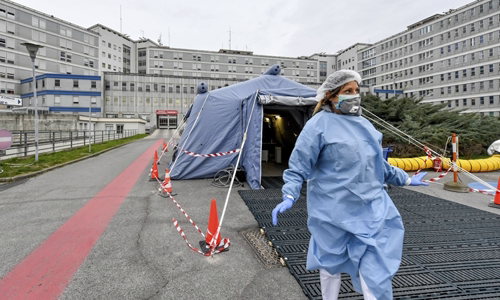Italy has an aging population, while elderly people with many background conditions when nCoV infection are more likely to have life-threatening serious complications.
The number of deaths from nCov in Italy has been steadily increasing in recent days. The country on March 12 recorded a new record on a record high day of 2,651, bringing the total number of people with Covid-19 to 15,113.

A female paramedic came out of a tent in front of the emergency department at Cremona Hospital, Lombardy, on February 29 Photo: AP.
Italy is also the country with the second highest number of deaths due to nCoV, only after China, with 1,016 cases. The death rate is nearly 7%, double the global average of 3.4%, according to the World Health Organization (WHO).
One factor influencing Italy's nCoV mortality rate is population age. The country has an average age of 47.3, among the oldest population in Europe with about 23% of people over 65. Many of the deaths in Italy's Covid-19 epidemic were those in their 80s and 90s, the age at which severe complications are most likely to occur after infection with nCoV.
According to Aubree Gordon, professor of epidemiology at the University of Michigan, the overall mortality rate always depends on the demographic characteristics of the population. In the case of Italy, "we will see their mortality rates are higher than average, with all other factors being kept on par" compared to a country with a younger population, Professor Gordon said. .
In addition, as people age, the likelihood of developing at least one factor that weakens the body's immune system, such as cancer or diabetes, according to Krys Johnson, epidemiologist at Temple University School of Public Health, USA. Such factors also make a patient's condition worse when infected with nCoV.
Another possible reason is the number of people in a certain area who need medical care. When many seriously ill people are concentrated in one area, the local health system will become overwhelmed, Gordon noted.
Gordon took Wuhan, the capital of Hubei province, China, where Covid-19 broke out, as an example. A recent report published by the WHO shows that the nCoV mortality rate in Wuhan is 5.8%, many times higher than the 0.7% in the rest of China.
Finally, Italy may not be able to detect many mild nCoV infections, making the actual number of cases low. Normally, when the test is expanded to the community, authorities will detect more mild cases, thereby increasing the number of infections and reducing the overall death rate. This is the case in South Korea, which conducted more than 140,000 nCoV tests and had a mortality rate of only 0.6%.
"We don't know exactly how many people are actually infected," Johnson said. People who exhibit only mild symptoms or young people may not be tested. Therefore, Johnson predicted that Italy's real mortality rate is only equal to the global death rate of 3.4%.
Italy has conducted more than 42,000 nCoV tests (data as of March 7). However, the disease is still complicated and will likely break out on a larger scale, requiring more tests to be done, Gordon stressed.



 ElizabethShaw
ElizabethShaw







